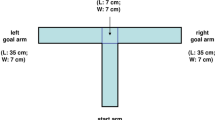Abstract
This protocol details a method for using a T-maze to assess the cognitive ability of rodents. The T-maze is an elevated or enclosed apparatus in the form of a T placed horizontally. Animals are started from the base of the T and allowed to choose one of the goal arms abutting the other end of the stem. If two trials are given in quick succession, on the second trial the rodent tends to choose the arm not visited before, reflecting memory of the first choice. This is called 'spontaneous alternation'. This tendency can be reinforced by making the animal hungry and rewarding it with a preferred food if it alternates. Both spontaneous and rewarded alternation are very sensitive to dysfunction of the hippocampus, but other brain structures are also involved. Each trial should be completed in under 2 min, but the total number of trials required will vary according to statistical and scientific requirements.
This is a preview of subscription content, access via your institution
Access options
Subscribe to this journal
Receive 12 print issues and online access
$259.00 per year
only $21.58 per issue
Buy this article
- Purchase on Springer Link
- Instant access to full article PDF
Prices may be subject to local taxes which are calculated during checkout

Similar content being viewed by others
References
Crawley, J. & Goodwin, F.K. Preliminary report of a simple animal behavior model for the anxiolytic effects of benzodiazepines. Pharmacol. Biochem. Behav. 13, 167–170 (1980).
Dixon, R.M., Bradley, K.M., Budge, M.M., Styles, P. & Smith, A.D. Longitudinal quantitative proton magnetic resonance spectroscopy of the hippocampus in Alzheimer's disease. Brain 125, 2332–2341 (2002).
Deacon, R.M.J., Bannerman, D.M. & Rawlins, J.N.P. Conditional discriminations based on external and internal cues in rats with cytotoxic hippocampal lesions. Behav. Neurosci. 115, 43–57 (2001).
Dember, W.N. & Richman, C.L. Spontaneous Alternation Behavior (Springer, New York, 1989).
Olton, D.S., Becker, J.T. & Handelmann, G.E. Hippocampus, space and memory. Behav. Brain Sci. 2, 315–365 (1979).
Deacon, R.M.J., Penny, C. & Rawlins, J.N.P. Effects of medial prefrontal cortex cytotoxic lesions in mice. Behav. Brain Res. 139, 139–155 (2003).
Reisel, D. et al. Spatial memory dissociations in mice lacking GluR1. Nat. Neurosci. 5, 868–873 (2002).
Deacon, R.M.J. & Rawlins, J.N.P. Hippocampal lesions, species-typical behaviours and anxiety in mice. Behav. Brain Res. 156, 241–249 (2005).
Rawlins, J.N.P. & Olton, D.S. The septo-hippocampal system and cognitive mapping. Behav. Brain Res. 5, 331–358 (1982).
Morris, R.G.M., Garrud, P., Rawlins, J.N.P. & O'Keefe, J. Place navigation impaired in rats with hippocampal lesions. Nature 297, 681–683 (1982).
Lalonde, R. The neurobiological basis of spontaneous alternation. Neurosci. Biobehav. Rev. 26, 91–104 (2002).
Whishaw, I.Q. & Tomie, J.-A. Of mice and mazes: Similarities between mice and rats on dry land but not water mazes. Physiol. Behav. 60, 1191–1197 (1997).
Guenther, K., Deacon, R.M.J., Perry, V.H. & Rawlins, J.N.P. Early behavioural changes in scrapie-affected mice and the influence of dapsone. Eur. J. Neurosci. 14, 401–409 (2001).
King, D.L. et al. Progressive and gender-dependent cognitive impairment in the APPSW transgenic mouse model for Alzheimer's disease. Behav. Brain Res. 103, 145–162 (1999).
Pothion, S., Bizot, J.C., Trovero, F. & Belzung, C. Strain differences in sucrose preference and in the consequences of unpredictable chronic mild stress. Behav. Brain Res. 155, 135–146 (2004).
Handley, S.L. & Mithani, S. Effects of alpha-adrenoceptor agonists and antagonists in a maze-exploration model of 'fear'-motivated behaviour. Naunyn-Schmiedeberg's Arch. Pharmacol. 327, 1–5 (1984).
Lister, R.G. The use of a plus-maze to measure anxiety in the mouse. Psychopharmacology 92, 180–185 (1987).
Contet, C., Rawlins, J.N.P. & Deacon, R.M.J. A comparison of 129S2/SvHsd and C57BL/6JOlaHsd mice on a test battery assessing sensorimotor, affective and cognitive behaviours: implications for the study of genetically modified mice. Behav. Brain Res. 124, 33–46 (2001).
Deacon, R.M.J. Appetitive position discrimination in the T-maze. Nat. Protocols 1, 13–15 (2006).
Fellows, B.J. Chance stimulus sequences for discrimination tasks. Psychol. Bull. 67, 87–92 (1967).
Acknowledgements
This work was supported by grant GR065438MA from the Wellcome Trust to the Oxford OXION group.
Author information
Authors and Affiliations
Corresponding author
Ethics declarations
Competing interests
The authors declare no competing financial interests.
Rights and permissions
About this article
Cite this article
Deacon, R., Rawlins, J. T-maze alternation in the rodent. Nat Protoc 1, 7–12 (2006). https://doi.org/10.1038/nprot.2006.2
Published:
Issue Date:
DOI: https://doi.org/10.1038/nprot.2006.2
This article is cited by
-
In-vivo integration of soft neural probes through high-resolution printing of liquid electronics on the cranium
Nature Communications (2024)
-
Doxycycline-Loaded Calcium Phosphate Nanoparticles with a Pectin Coat Can Ameliorate Lipopolysaccharide-Induced Neuroinflammation Via Enhancing AMPK
Journal of Neuroimmune Pharmacology (2024)
-
Anti-apoptotic effect of menaquinone-7 protects the brain of ovariectomized rats
Beni-Suef University Journal of Basic and Applied Sciences (2023)
-
Behavioral phenotype, intestinal microbiome, and brain neuronal activity of male serotonin transporter knockout mice
Molecular Brain (2023)
-
Circular RNA Tmcc1 improves astrocytic glutamate metabolism and spatial memory via NF-κB and CREB signaling in a bile duct ligation mouse model: transcriptional and cellular analyses
Journal of Neuroinflammation (2023)
Comments
By submitting a comment you agree to abide by our Terms and Community Guidelines. If you find something abusive or that does not comply with our terms or guidelines please flag it as inappropriate.



